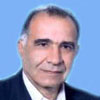Survey Efficiency of Heavy Metals Adsorption (Cu, Cd and Pb) in Aqueous Solution on the Saffron Leaves and Determine the Adsorption Isotherms
Author(s):
Abstract:
Background
The presence of heavy metals in the environment, especially in the water creates many health problems. Effective technology for the removal of some of the other methods that are attractive from an economic standpoint, the availability and high power in remove the rest of their advantages. The aim of this study was to investigate the uptake of heavy metals (Cu, Cd and Pb) by the saffron leaves of the aquatic environment in the area is available as an absorbent.Materials and Methods
An experimental study in the spring and summer in 2013 in Environmental Health Engineering Research Center of Kerman University of medical was performed. Plantations of Razavi Khorasan dried saffron leaves were used as absorbents. Batch experiments were performed at room temperature on a synthetic and real sample. The effects of PH solution, absorbent dose, contact time, initial concentration of heavy metals absorption isotherms were determined and discussed. Experiments were performed in duplicate, to determine of mean was used the SPSS version 15.Results
PH optimal removal of heavy metals copper, cadmium and lead saffron leaves the absorber was 5. The optimum absorbent for metals (0.5, 1.5 and 1.5 g) and the equilibrium contact times (45, 90 and 90 min), respectively. The optimum conditions for the removal of the 55.75 %, 81.89 % and 83.56 %, respectively. With increasing initial concentrations of copper, cadmium and lead in solution, the removal efficiency decreased. PH was important for the uptake of heavy metals. In actual samples (Martyr Bahonar Copper Industries and battery niruelectronics) optimal amount of adsorbent (1.5, 2and 2 g) and contact times (60, 90, and 90 minutes) respectively. The optimum conditions for the removal of metals, 45.12 %, 68.78 % and 73.53 % respectively. Results from this study showed the highest correlation with the Langmuir isotherm model.Conclusion
The results of the saffron plant leaves absorb more lead than copper metal, copper and cadmium but with more energy will be absorbed. Readily available plant leaves in area and inexpensive absorbent according to the results of this method can be as a practical method to remove heavy metals from industrial waste water can be used.Keywords:
Language:
Persian
Published:
Journal of Torbat Heydariyeh University of Medical Sciences, Volume:1 Issue: 3, 2013
Page:
15
magiran.com/p1264447
دانلود و مطالعه متن این مقاله با یکی از روشهای زیر امکان پذیر است:
اشتراک شخصی
با عضویت و پرداخت آنلاین حق اشتراک یکساله به مبلغ 1,390,000ريال میتوانید 70 عنوان مطلب دانلود کنید!
اشتراک سازمانی
به کتابخانه دانشگاه یا محل کار خود پیشنهاد کنید تا اشتراک سازمانی این پایگاه را برای دسترسی نامحدود همه کاربران به متن مطالب تهیه نمایند!
توجه!
- حق عضویت دریافتی صرف حمایت از نشریات عضو و نگهداری، تکمیل و توسعه مگیران میشود.
- پرداخت حق اشتراک و دانلود مقالات اجازه بازنشر آن در سایر رسانههای چاپی و دیجیتال را به کاربر نمیدهد.
In order to view content subscription is required
Personal subscription
Subscribe magiran.com for 70 € euros via PayPal and download 70 articles during a year.
Organization subscription
Please contact us to subscribe your university or library for unlimited access!


